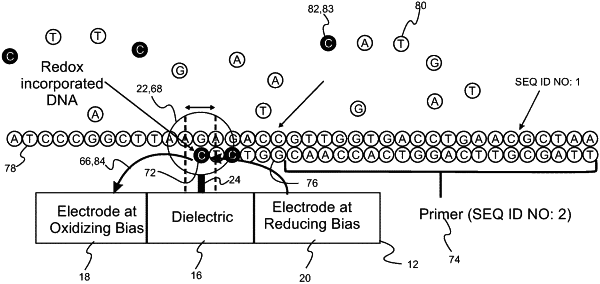| CPC C12Q 1/6869 (2013.01) [B01J 19/0093 (2013.01); B01L 3/502715 (2013.01); G01N 27/307 (2013.01); G01N 27/3272 (2013.01); G01N 27/3275 (2013.01); G01N 33/526 (2013.01); B01L 2300/0645 (2013.01)] | 22 Claims |

|
1. A method for nucleic acid sequencing, the method comprising the steps of:
providing at least one device including:
an oxidizing electrode,
a reducing electrode,
a dielectric member positioned between the oxidizing electrode and reducing electrode, wherein dielectric member separates the reducing electrode from the oxidizing electrode by a first distance of at most 10 nm, and
a protein attached to a surface of the dielectric member, the protein capable of translocating a polynucleotide strand having a modified nucleotide with a redox label covalently bonded to the nucleoside base of the modified nucleotide or,
wherein the oxidizing electrode and the reducing electrode generate an electric field extending to a reaction area where the translocation of the polynucleotide strand through the protein occurs;
directing current through the oxidizing electrode and the reducing electrode, wherein the oxidizing electrode and the reducing electrode each have a length of 50 nm to 5,000 nm and a width of 10 nm to 1,000 nm in contact with a sample including the polynucleotide strand;
exposing the protein to a sample including the polynucleotide strand, wherein the polynucleotide strand is translocated through the protein; and
detecting changes in current flow in the oxidizing electrode and the reducing electrode, wherein the changes identify electron transfer from the reducing electrode, to redox label, and to oxidizing electrode when the modified nucleotide with a redox label covalently bonded to the nucleoside base of the modified nucleotide of the polynucleotide strand is at the reaction area.
|